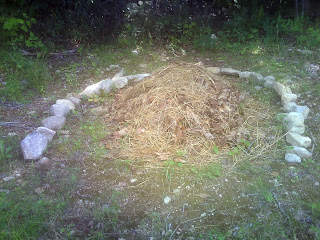 |
Image: aroid/Flickr
|
How to Identify Aphids
Adult Aphids: These adult garden pests grow from
1/16 - 3/8 of an inch in size as adults. They have pear-shaped bodies, some
with wings that grow longer than the body. Aphids range in color from powder
grey, black, green, yellow and pink.
Nymphs: Nymphs are slightly smaller than adults and
have no wings.
When Aphids Attack
Aphids can mount an attack any time during the growing
season due to their life cycles. Females can produce nymphs all on their own.
Those nymphs, which take abut 1 - 2 weeks to mature, then produce nymphs
themselves and thus the cycles continues. The cycle is able to continue in cold
climates because female aphids lay their eggs in fall with the eggs hatching in
spring.
Common Plants Aphids Attack
- Fruit Plants
- Vegetable Plants
- Flowers
- Ornamentals
- Shade Trees
How to Identify Damage Caused by Aphids
Aphids are known in the world of garden pests as being sap
suckers. This often leads to leaves, buds, branch tips and flowers becoming
disfigured and droopy. Plants suffering from a severe aphid infestation can
lose their leaves.
Furthermore, as these garden pests feed on plant sap, they
secrete a substance, both sticky and sweet. Mold has a tendency to grow from
their secretions, blocking light to the leaves below. To make matters worse,
aphids can spread disease from one plant to another making controlling these
garden pests a priority in the garden.
5 Ways to Control Aphids Organically
1. Water from the Hose: Set the hose to a strong
spray and rinse away aphids. Since aphids are tiny and delicate, a strong stream from the hose or driving rain is enough to kill them.
2. Dormant Oil: In fall, spray dormant oil on fruit
trees on the property. The oil will kill aphid eggs.
3. Pollen/Nectar Rich Plants: Plant flowers and
plants that are heavy pollinators and those that offer lots of nectar. (Yarrow,
sweet alyssum etc.) These types of plants attract “good bugs” which prey
on aphids.
4. Ant Control: Some ants protect aphid colonies
that have taken over fruit trees. To control the ants organically, wrap
sticky bands around the trunks of infested trees.
5. Soaps, Oils and Sprays: Spray affected plants
with insecticidal soap, summer oil or a garlic spray. Make sure the soaps,
spray and oils are organic and the plants being sprayed can tolerate them.
The writers of Rodale Gardening Basics: Pests,
suggest making a homemade garlic spray by soaking 10 - 15 finely chopped garlic
gloves in 1 pint of mineral oil for 24 hours. Strain the oil which can be diluted,
and use as needed.
For organic gardeners, controlling bad bugs such as aphids
is a must. Too much hard work from planning, planting, weeding and watering
goes into an organic vegetable garden to let garden pests take over and enjoy the bounty.
Keep an eye out for aphids and other pests and begin controlling them from the
first sign that they are in the garden.
Related Articles
Reference: Rodale Organic Gardening (2001). Basics:Pests Volume 7. Rodale Inc.















